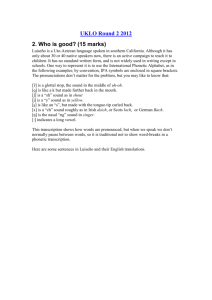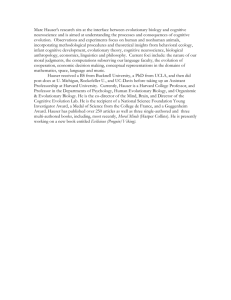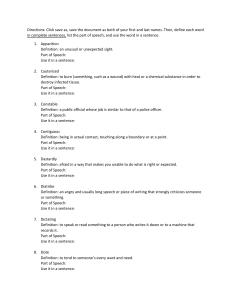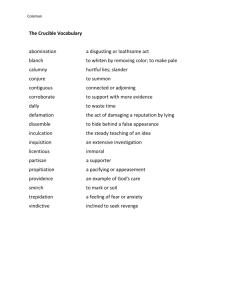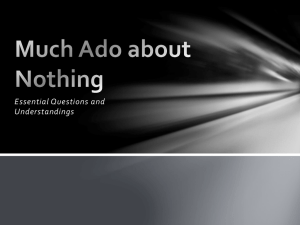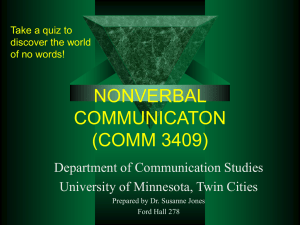Default Normal Template
advertisement
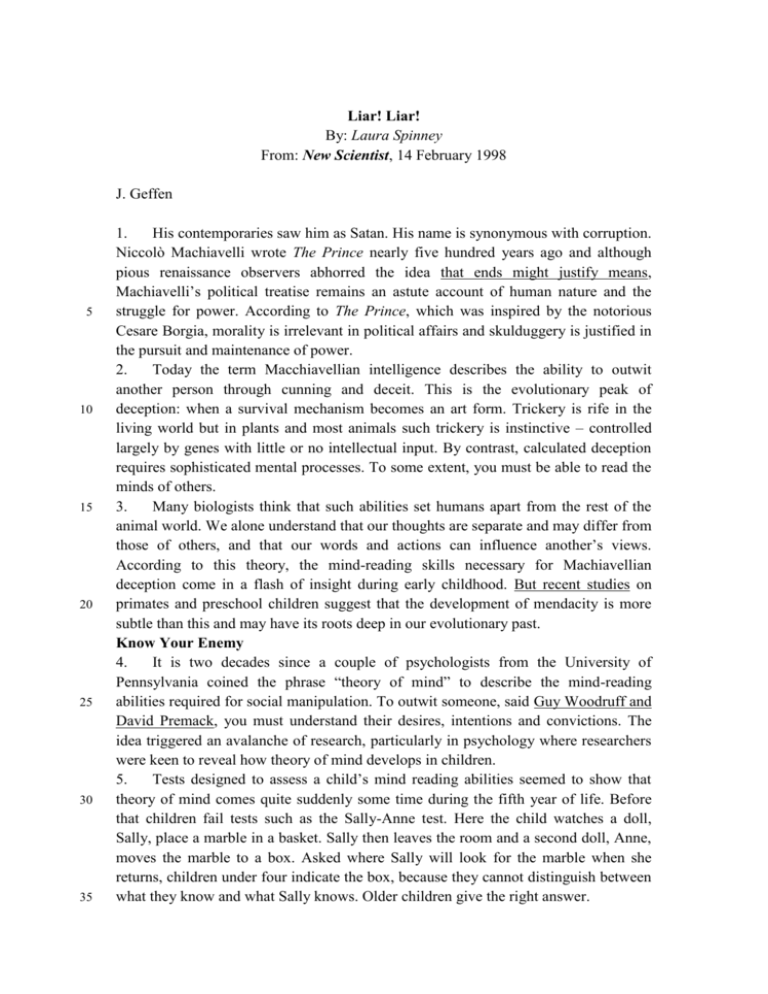
Liar! Liar! By: Laura Spinney From: New Scientist, 14 February 1998 J. Geffen 5 10 15 20 25 30 35 1. His contemporaries saw him as Satan. His name is synonymous with corruption. Niccolò Machiavelli wrote The Prince nearly five hundred years ago and although pious renaissance observers abhorred the idea that ends might justify means, Machiavelli’s political treatise remains an astute account of human nature and the struggle for power. According to The Prince, which was inspired by the notorious Cesare Borgia, morality is irrelevant in political affairs and skulduggery is justified in the pursuit and maintenance of power. 2. Today the term Macchiavellian intelligence describes the ability to outwit another person through cunning and deceit. This is the evolutionary peak of deception: when a survival mechanism becomes an art form. Trickery is rife in the living world but in plants and most animals such trickery is instinctive – controlled largely by genes with little or no intellectual input. By contrast, calculated deception requires sophisticated mental processes. To some extent, you must be able to read the minds of others. 3. Many biologists think that such abilities set humans apart from the rest of the animal world. We alone understand that our thoughts are separate and may differ from those of others, and that our words and actions can influence another’s views. According to this theory, the mind-reading skills necessary for Machiavellian deception come in a flash of insight during early childhood. But recent studies on primates and preschool children suggest that the development of mendacity is more subtle than this and may have its roots deep in our evolutionary past. Know Your Enemy 4. It is two decades since a couple of psychologists from the University of Pennsylvania coined the phrase “theory of mind” to describe the mind-reading abilities required for social manipulation. To outwit someone, said Guy Woodruff and David Premack, you must understand their desires, intentions and convictions. The idea triggered an avalanche of research, particularly in psychology where researchers were keen to reveal how theory of mind develops in children. 5. Tests designed to assess a child’s mind reading abilities seemed to show that theory of mind comes quite suddenly some time during the fifth year of life. Before that children fail tests such as the Sally-Anne test. Here the child watches a doll, Sally, place a marble in a basket. Sally then leaves the room and a second doll, Anne, moves the marble to a box. Asked where Sally will look for the marble when she returns, children under four indicate the box, because they cannot distinguish between what they know and what Sally knows. Older children give the right answer. Liar! Liar / 2 40 45 50 55 60 65 70 75 6. The implication of such findings is that young children do not have the mindreading abilities necessary to deceive, either through their actions or words. But recent research refutes the idea that age four is a watershed when deception begins. Lying and cheating come naturally to us long before that, argue Vasudevi Reddy, a psychologist at the University of Portsmouth and her colleague Paul Newton. Last year they announced findings from a study which showed that three-year-old children may fail the Sally-Anne test yet skilfully hoodwink other individuals. 7. As well as testing these children in their lab, Reddy and Newton asked mothers to scrutinise the day-to-day behaviour of their young offspring. The result was a startling catalogue of subterfuge – not just formulaic fibs learnt by association, but highly creative lies tailored to individual situations, such as feigning indifference to a coveted toy so that a sibling might consider the object not worth holding onto. 8. The misinformation that infants communicate can be as rich and varied as their information, says Reddy. “All the infancy data … point to the idea that infants are dealing sensitively and intelligently with other people’s mentality well before you can say they have a concept of mind.” If young children can manipulate other people even before the theory of mind forms, she argues, just how valuable can the theory be? Reddy believes children don’t come to understand other people’s minds through some breakthrough in psychological development, but instead understanding comes gradually through a growing familiarity with the way that people interact. 9. Support for the idea that mind-reading develops as a continuum is gathering momentum. In 1994, Wendy Clements, an experimental psychologist at the University of Sussex, and Joseph Perner of the Department of Psychology at the University of Salzburg tested children aged between two and four on a more sensitive version of the Sally-Anne test. They filmed the children and monitored the direction of their gaze as well as their outward responses, either in words or gestures. Ninety per cent of the children tested – including some two-year-olds – looked at the place where “Sam the mouse” had originally hidden the object, yet fewer than half of them indicated it explicitly. In a control test – where Sam saw the object being moved to a new location – none of these children looked at the original hiding place. 10. Clements believes that the children knew the right answer, but were not yet sufficiently consciously aware of their knowledge to verbalise it. She makes the analogy with patients suffering from the neurological condition called blindsight. They can accurately point to an object in their impaired visual field yet do not know how they did it. In people with blindsight, the dissociation of implicit and explicit knowledge is caused by neurological damage. In the child’s developing mind, suggests Clements and Perner, an implicit understanding of what another person knows comes before an explicit understanding. 11. So, according to Clements and Perner, humans develop the rudiments of an ability to mind-read long before the fifth year. Reddy and Newton have documented manipulative behaviour in babies as young as ten months. These babies may pretend Liar! Liar / 3 80 85 90 95 100 105 110 115 to cry in an attempt to get their own way, or tease an adult by offering an object and then withdrawing it. If this truly is the start of Machiavellian intelligence, the new findings give animal behaviourists even more fuel to stoke a long-running and heated debate about whether non-human primates are capable of calculated deception. 12. Back in 1979, Premack and Woodruff published results from a study which they claimed showed that chimps have a theory of mind. When the two psychologists forced an animal to compete with a human for a concealed reward, the chimp would try to dupe the person by indicating the wrong hiding place and ignore its rival’s misleading cues. But in another trial where both of them had to cooperate for the reward, the chimp did not try to deceive the human and assumed that its companion would also be truthful. Could such an artificial situation really reveal mind reading abilities in chimps? Most primatologists remained unconvinced. 13. A decade later, Andrew Whiten and Richard Byrne, evolutionary psychologists at the University of St Andrews, took a different approach to answering the question of whether primates possess Machiavellian intelligence. They had seen what they believed to be calculated deception in their studies of apes and monkeys, and conversations with other researchers convinced them that such practices were widespread. Most of the evidence was anecdotal, but by painstakingly compiling a record of examples, Whiten and Byrne believed they could persuade other biologists that humans are not the only animals able to bamboozle one another. Cheeky Monkeys 14. The result was a catalogue of observations (“A thinking primate’s guide to deception”, New Scientist, 3 December 1987, p 54) which by 1990 had grown to 253 entries. The database includes numerous examples of female infidelity, both in monkeys and apes. Females would hide from the view of the dominant male and suppress their copulation calls as they mated with subordinate males, so as to reduce the chances of violent reprisal. Another example was the vervet monkey which, finding itself cornered following a chase by angry members of its troop, looked to the horizon and emitted an alarm call to signal the arrival of a predator. Distracted, his aggressors climbed the trees to search for the nonexistent danger and the chase was called off. 15. Despite the quantity and quality of the anecdotes, Whiten and Byrne agree with other biologists that these alone do not prove the existence of Machiavellian intelligence in primates. But as far as the great apes are concerned, they believe the data point to a “real theory of mind understanding”, but that claim is not, they say, justified for other primates. Instead of skilfully manipulating their fellows using an ability to mind-read, they might merely be re-enacting tricks which trial and error had showed to work under particular circumstances. The vervet monkey, for example, might know that shrieking would distract its aggressors, but not understand how. If in the past the monkey really had spotted a predator while being chased it could have learned to associate the warning call with its own escape. Liar! Liar / 4 120 125 130 135 140 145 150 155 16. Is it possible to distinguish between intentional deception and tactics learnt by trial and error? Today, attempts to crack this problem often rely on the sort of test developed to assess theory of mind in young children. The latest research will be discussed at a symposium held by the International Primatological Society in Madagascar this August. 17. At the meeting Joseph Call from the University of Liverpool will describe a study done with Michael Tomasello of Emory University, Atlanta, to compare the mind-reading abilities of chimps, orang-utans and four and five-year-old children. Using a non-verbal version of the Sally-Anne test, the researchers found that children performed as predicted: only four-year-olds failed. No ape passed the test. Call concludes that only humans are capable of distinguishing between what they know and what others know. But he concedes that, like the young children in Reddy and Newton’s study, chimps and orang-utans might possess the rudiments of mind-reading without having enough understanding to pass the Sally-Anne test. 18. How can the naturalistic evidence of Whiten and Byrne be reconciled with the failure in mind reading tests of even our closest relatives? Mark Hauser of Harvard University believes he has the answer. He attributes the anomaly to flaws in the method. It is unfair, he argues, to test for a theory of mind in nonhumans with a task designed specifically for humans. With his colleague Laurie Santos, Hauser has tested cotton-top tamarins using a special version of the Sally-Anne test. 19. An actor sees an object being hidden, then a screen is raised to obscure his vision while the location of the object is changed. When the screen is lowered, the actor looks either in the original hiding place, as he would be expected to, or in the new location. Hauser and Santos filmed the response of monkeys so that they could assess the length of time animals spent looking at the actor. Psychologists routinely use this measurement when testing preverbal children, and assume that a longer stare indicates that the child’s expectation has been violated. Hauser and Santos found that monkeys looked longer when the actor searched in the new location. They believe this shows that tamarins understand that the actor cannot have knowledge of an event he hasn’t seen. Distant Relatives 20. Hauser’s results have surprised other researchers, not least because tamarins split from the hominid line an estimated 40 to 50 million years ago. If such deceptive powers have been honed through evolution then in theory tamarins should have poorer mind-reading abilities than chimps, which branched off only 5 to 6 million years ago. Hauser has yet to test chimps. Another puzzle is why tamarins might need an implicit understanding of another’s mental processes. Whiten points out that the dissociation of implicit and explicit understanding makes sense in young children because it is only a stage on the way to a full-blown theory of mind. “It’s strange to see something this complex in an animal if it isn’t being used more explicitly – to intentionally deceive, for example,” he says. “That’s not the way natural selection Liar! Liar / 5 160 165 170 175 180 185 works. Natural selection operates to refine and modify things because of their practical consequences.” 21. But Hauser argues that the “looking” response does not necessarily indicate implicit knowledge. It could equally be a different way of expressing explicit knowledge – the tamarin version of human speech. As for the large evolutionary gap separating tamarins from us, it is not impossible, he says, that we evolved the capacity to mind-read independently of each other. 22. Hauser goes even further. “There is a good chance that when we get more sophisticated with our techniques and procedures, we’re going to find that at least some primate species, and potentially some nonprimate species, will have the rudiments of a theory of mind.” Either way, he is convinced that the mental gap between nonhuman primates and humans is smaller than scientists used to think. The ruthless politician or entrepreneur may be at the top of the evolutionary tree of deception, but according to Hauser, Whiten, Byrne and others, apes and monkeys are surely to be found swinging in the branches below. 23. If the world of primates really is teaming with liars and cheats, it is likely that the ability to outwit another may be more than simply a useful tool. This is what Whiten argues in a book soon to be published. Deception, he says, has played a crucial role in evolution. When early hominids left their forest habitat to colonise the plains, 4 to 5 million years ago, they were physically ill-adapted to compete with the highly specialised carnivores already there. What they did have were the rudiments of Machiavellian intelligence. So instead of honing their bodies to slug it out with their rivals, they sharpened their minds to outwit the rest. Our ancestors survived, argues Whiten, only by carving out a unique “cognitive niche”. 24. If Whiten is correct, then the same evolutionary forces that created complex social organisation, giving early hominids power over other species, also shaped the Machiavellian mind that was responsible for the ruthless corruption of the Borgia family. Liar! Liar / 6 Answer in your own words. 1. 2. 3. What was the title of the book written by Machiavelli? Answer : ____________________________________________________________ Complete the sentence below. Machiavelli probably believed that his book presents the morals to be drawn from the life and achievements of ________________________________________ Answer the question below in English. What was the main moral to be drawn from Machiavelli’s book? Answer : ____________________________________________________________ Answer the question below in Hebrew. 4. In what sense is Machiavelli’s work consistent with the title of this article? Answer : ____________________________________________________________ 5. 6. Answer the question below in English. In what way does the trickery one sees in nature – paragraph 2 – differ from calculated deception? Answer : ____________________________________________________________ Answer the question below in English. What novel suggestion – paragraph 3 – have recent researches among primates and infants come up with? Answer : ____________________________________________________________ Answer the question below in Hebrew. 7. The existence of what qualities did Guy Woodruff and David Premack presuppose for the successful performance of an act of deception? Answer : ____________________________________________________________ Liar! Liar / 7 8. Answer the question below in English. a) What thesis is challenged by psychologists Vasudevi Reddy and Paul Newton? b) Name those who have lately supported Newton’s claims (paragraphs 6-10). Answer: a) b) 9. 10. 11. Answer the question below in English. Sum up the two theories concerning the appearance of mind-reading ability; which of the two is currently gaining more prominence? Answer : ____________________________________________________________ Answer the question below in English. To what conclusions – paragraph 11 – may the thesis, that humans develop the ability to mind-read in early infancy, eventually lead? Answer : ____________________________________________________________ Answer the question below in English. What would the sexual practices of some of the females, both monkeys and apes, suggest? (Generalize) Answer : ____________________________________________________________ 12. Answer the question below in English. In what sense, according to Joseph Call – paragraph 17 – are humans unique? Answer : ____________________________________________________________ 13. Answer the question below in English. Who are our closest relatives – paragraph 18? Answer : ____________________________________________________________ Liar! Liar / 8 14. Answer the question below in English. What claims were Hauser and Santos – paragraph 19 – trying to refute? Answer : ____________________________________________________________ Answer the question below in Hebrew. 15. Why did Hauser’s findings – paragraph 20 – appear unconvincing? Answer : ____________________________________________________________ Answer the question below in Hebrew. 16. What was the revolutionary essence – paragraphs 18-22 – of Hauser’s claims? (Generalize, do not specify) Answer : ____________________________________________________________ 17. 18. Answer the question below in English. To what does Hauser – paragraphs 18-22 – attribute human failure to discern the capabilities of some primate species to mind read? Answer : ____________________________________________________________ Answer the question below in English. How does Whiten – paragraph 23 – account for Man’s success? Answer : ____________________________________________________________ Answer the question below in Hebrew. 19. What is the main idea in this article? Answer : ____________________________________________________________
